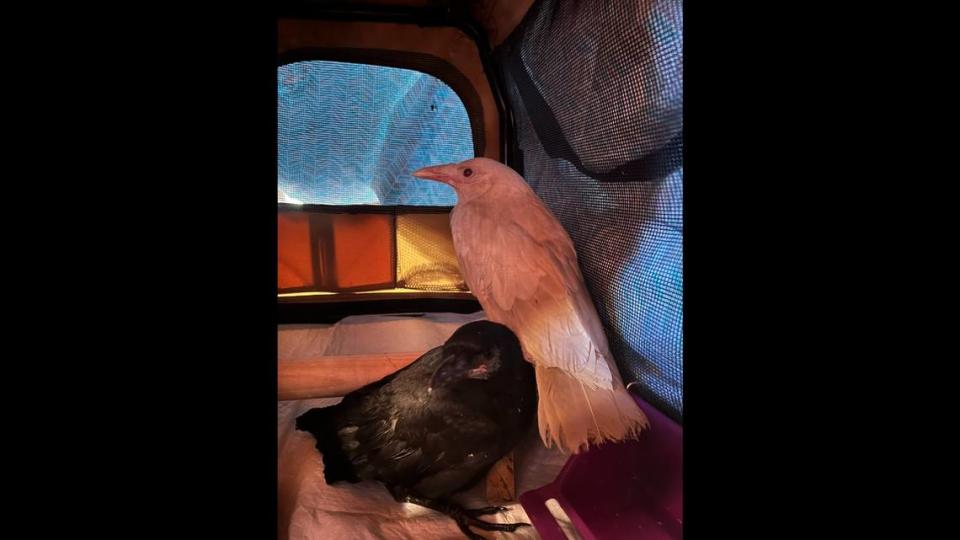An albino crow? A baby one was just discovered in Connecticut. See the rare creature
A crow’s coloring can make it an easily recognizable bird. However, not all crows have the same, dark plumage they’re commonly known for.
Sometimes, a crow’s feathers can display shades of white and, rarely, an albino one may be spotted.
A baby albino fish crow with pink eyes was discovered on July 11 in Connecticut in an uncommon sighting, according to A Place Called Hope, a wildlife rehabilitation and education center for birds of prey in Killingworth.
The snow-colored bird is a fledgling — meaning it’s about a few weeks old — and is being cared for at the center after it was found injured and unable to fly, A Place Called Hope wrote in a July 11 Facebook post, the day the bird was admitted there.
There is a 1-in-30,000 chance of seeing an albino crow, the center said.
While 1% of crows may be leucistic with white feathers, they’re not considered albino because they have colored eyes instead of pink, the center explained.
This is the first known report of an albino fish crow in Connecticut, state Department of Energy and Environmental Protection spokesman Paul Copleman told McClatchy News on July 14.
Fish crows are a smaller species of crow and tough to distinguish from American crows. One clue signaling a crow is a fish crow is its call, which has a nasal sound.
How the albino crow was found
A family in Wallingford came across the albino, fledgling fish crow struggling to get itself off the ground on July 11, Christine Cummings, the president of A Place Called Hope, told McClatchy News on July 14.
“An adult ‘black’ bird was with it, trying to coax it along,” she said in emailed statements.
Although the bird should’ve been able to somewhat fly because it is a fledgling, it kept “falling and misjudging its environment,” Cummings said.
When the family called the center about the bird, they were advised to put it in a box so it could be rehabilitated, according to Cummings.
“Once it was decided to intervene, the finder went back out to box the bird, and it was gone,” Cummings said. “So we all hoped (for) the best, and imagined it was stunned, and perhaps righted itself while no humans were around.”
Some time afterward, the bird was discovered again and brought to the center with a noticeable, soft tissue injury to its left wing and vision impairment, according to Cummings.
Although X-rays of its wings didn’t show any fractures, a veterinarian will examine the bird further, the center wrote on Facebook.
As for the crow’s future, it’s likely the center will become its permanent home, since its white coloring puts it “at a disadvantage against predation” and the bird has issues with sight, Cummings said.
Albinism in any wildlife species is considered a “genetic rarity,” according to Copleman.
This is because albino animals “lack the typical features that make them less susceptible to predators or give them advantages that come with a more traditional color pattern,” he said. “Essentially, the genes that lead to albinism don’t get replicated frequently in wild populations.”
The fledgling albino crow has a “roommate” — another young fish crow with black feathers — at the center. This fish crow survived a nest raiding that killed its sibling, according to A Place Called Hope.
Photos shared by the organization show the pair resting together with their contrasting plumage.

“We consider this bird to be a sacred messenger, this rarity represents trust, purification, clear vision, healing, and overall good fortune,” Cummings said of the albino fish crow.
When possible, A Place Called Hope tries to reunite injured, orphaned or recovered birds back to their natural home following rehabilitation, according to Cummings.
Killingworth, where the center is located, is about 35 miles south of Hartford.
See elusive wolverine family slide down snow bank in ‘unique sighting’ in Alaska
Rare twin giant panda cubs born at South Korean zoo. See the tiny, squirming cubs
Rare creature leaves photographer ‘speechless’ as it swims near Australian reef. See it

